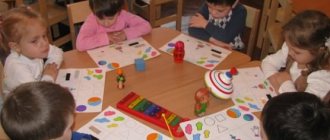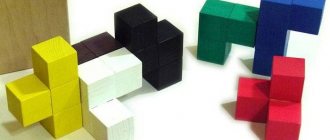The game of checkers, along with chess, is rightfully recognized as one of the most intellectual games. It stimulates:
- mental activity of children;
- develops spatial imagination;
- trains attention and memory;
- develops logic;
- develops communication skills;
- instills perseverance.
When can you start learning to play checkers?
Kindergarten age is considered the most appropriate to begin a step-by-step learning of the rules of the game of checkers. The skills that a child will acquire as a result of the game: to calculate the situation several moves ahead, make important decisions and bear responsibility for them - qualities that will be very useful to him in adult life.
There are several variations of the game in the world - Turkish, English, Italian checkers. They differ in color palette, move options, number of fields and, accordingly, the number of pieces. Let's focus on classic Russian checkers.
Checkers game: rules
- The checkers board for the Russian version of the game consists of 64 squares, painted black and white; the checkers are also black and white. Before the start of the fight, all figures are placed in the bottom three rows against a dark background.
- All moves in the game are carried out only on a dark background.
- The advantage of the first move always belongs to the white pieces.
- The figure moves forward diagonally to any free cell.
- If the player touches a piece, then he must move to it.
- The moves between the opponents alternate.
- If there is an enemy piece in front of the checker, and the field is free after it, then it can be eaten by making a move both forward and backward.
- Walking in the other direction with this position of the pieces is prohibited, even if you expose yourself to a blow
- In one move, if the enemy pieces are positioned well, you can eat several checkers at once.
- If the player managed to reach the opposite end of the board, then he turns over his piece, it turns into a king.
- The queen can move diagonally forward any number of squares. The queen also has access to backward moves.
- Any figure can eat the queen, given the appropriate position.
- The first player to eat all of the opponent's checkers wins.
Pioneer checkers
In children's camps, a cross between pillar checkers and corner checkers is still popular (not to confuse corner checkers with corners), i.e. The game goes with towers corner to corner, you can walk forward from your corner and to the side. You can't go back to your corner. Victory in pioneer checkers is considered to be either eating all of the opponent's checkers, or entering the last square of the opponent's corner.
Otherwise, the same rules of Russian post checkers:
- Each beaten simple checker is not removed from the field, but is placed under the tower that defeated it.
- A tower of several checkers belongs to the player of the color of the topmost checker and moves across the field all at once as a single checker.
- The movement of the tower occurs according to the rules of a simple checker, if it does not have a simple checker on top, or according to the rules of a king, if it has a king on top.
- A tower can go into kings, but only its top checker becomes a king.
- If a tower was defeated, then the top checker is removed from it and placed under the tower that defeated it.
- If a checker or tower hits several enemy checkers or towers, then the captured checkers are placed under the hitting piece sequentially.
- The game ends with victory when all the opponent's checkers are captured.
Let's look at examples of combat in pioneer checkers (for clarity, we do not draw all the checkers on the field):
|
|
How to teach a child to play checkers?
- The first lesson should begin with familiarization with the playing field. Let the child first try to arrange the figures correctly on his own; if it doesn’t work, come to the rescue.
- No need to hurry. Play only when the child wants it.
- Don't let your baby become overtired. No matter how interesting your game is, it is necessary to take breaks for physical education.
- Praise, encourage your child, create a situation of success for him, point out the most successful combinations, inspire victories and new achievements.
- Don’t scold if your child doesn’t understand something or makes the wrong move, be more patient.
- Don't give in! If the child wins all the time due to the fact that you have successfully “arranged” everything, then there will be no sense in such a game.
Along with the classic game of checkers, you can teach your child to play “Chapaev” and “Ugolki”. These types of checkers are no less interesting and exciting.
Rules of the game "Corners"
- The player must place a house of checkers.
- One person posts at the top of the board on the right, and the second participant at the bottom left.
- The house is built in the form of a rectangle, 4 pieces are placed in length, 3 pieces in height.
- Using horizontal and vertical movements of checkers, the opponent must arrange moves for himself in order to quickly move all the components to the opponent’s place. You are allowed to jump over one, two or three checkers.
- You can stop the moves yourself at any time.
- The game will be considered over if one of the participants is the first to transfer all the checkers to the opposite place of the opponent.
Explain to your child the strategy for playing corners:
- You need to strive to make several jumps in one move - this way the checker will quickly move to the opposite corner and create conditions for “multi-jump” moves, placing one or more checkers so that you can “jump” over them.
- As soon as possible you need to remove the checkers from your corner, lining them up closer to the center. This creates a barrier that blocks enemy moves. The farther from your home you can place this barrier, the better.
- Try to line up checkers so that the enemy is forced to bypass your barrier in order to gain time.
Rules of the game "Chapaev"
- Each side must place checkers in horizontal rows, 8 pieces in each row.
- The opponent must click his finger on the chips to knock out everything from the opponent.
- The end of the game will be considered when all the opponent's pieces are knocked out.
- The opponent begins his move after one participant loses his piece or fails to knock out someone else’s.
- The player who was the first to knock out all the chips from the opponent moves one row higher in the second round.
In addition to its developmental value, playing checkers instills in children qualities that are important for their future life, such as the ability to think independently and bear responsibility for decisions made, and to deal adequately with failures and defeats. Since most children in preschool age are by nature very mobile and active and find it difficult to concentrate their attention for a long time, playing checkers develops in them such a quality as perseverance.
I hope the article was useful to you and you can easily teach your child to play checkers. I advise you not to forget about playing chess. Good luck!
Summary of the lesson “Miracle of Checkers” for middle-aged children.
Author: Konstantinova Daria Sergeevna
teacher at Children's Preschool Educational Institution "Kolobok"
Summary of the lesson “Miracle of Checkers” for middle-aged children.
Direct educational activity
“Miracle of Checkers”
Purpose:
Teach children to play checkers.
Tasks:
To consolidate children's knowledge about the game of checkers, to consolidate the rules of the game, the ability to use number as a result of measurement, to determine the equality of several groups of objects by number (the same number, 32, 12 each, the same number, equally, the concepts of even and odd numbers.
Exercise in the ability to navigate on a plane, consolidate concepts: vertical, horizontal lines, introduce the diagonal line, in the ability to create an activity algorithm.
Enrich children's vocabulary with new words: checkers player, tournament, partner, diagonal, draw.
Develop an interest in the game of checkers, the ability to be friendly and respectful towards each other, the desire to strive for success, and cultivate a sense of self-confidence.
Material:
Checkers.
Progress of activities:
— I want to inform you that this month in our city there will be a checkers tournament among children who go to kindergartens. Would you like to take part?
Then I suggest you start preparing for this tournament, remember everything we know about the game of checkers and consolidate the rules of the game.
I.
— Guys, how many of you know what a tournament is? (type of competition)
— What is the name of the person who plays checkers? (Checkers player)
- What should a checkers player be like? (Well-mannered, seasoned, kind, etc.)
— What do you need to play checkers? (Partner, checkers board, checkers, knowledge of the rules of the game)
Children present an algorithm.
- Who can play checkers? (Anyone)
— Who can be a partner for the game? (Anyone)
— How do partners greet each other at the beginning and end of the game? (Shake hands at the beginning and end of the game)
II.
— Guys, the checkers board is very unusual and is fraught with a lot of mysterious mysteries. Let's try together to unravel and declassify all the strange secrets of the magic board.
The children sit at the tables.
- I will ask you questions, and you try to answer them accurately, carefully peering at the checkers board, slowly studying it.
- What do you see on the board? (Identical small squares that alternate in color)
- How are they similar and how are they different? (Similar in shape and size, but different in color)
- “All in squares - white, black, checkerboard ...”
Count how many white and black cells there are? Boys count white squares, and girls count black squares. (White cells 32, black cells 32)
- What can be said about the number of black and white cells? (The same number, equally, 32 each, as many whites as there are blacks)
- I want to tell you that cells can be white and brown, white and green, white and red, but they are always called white and black.
What is the name of each of the squares or cells? (Field)
— Check, have you positioned your boards correctly?
Remember that the corner box on the right is always white, and the corner box on the left is always black.
- Do you know that the checkers board consists not only of square fields, but also of many different paths, paths, and they have different names.
What are the names of straight lines that go from left to right and right to left? (Horizontal lines)
- Count how many there are on the board? (8 horizontal lines)
- Now label each line with a number. The number is placed on the side to the left and right of the board. But we will only put it on the left. (performed with children)
- What are the lines that go from top to bottom and bottom to top called? (Vertical lines)
— Yes, and they are designated by numbers of the Latin alphabet. I suggest you draw one horizontal line with a blue pencil and one vertical line with a red pencil, and compare them in length.
—Which line is longer: horizontal or vertical? (Lines are equal)
- I suggest you play. To do this you need to split into two teams.
(Children take the numbers and divide them into even and odd)
— The evil wizard scattered the checker boards horizontally. We need to collect them, let's try! (Children do the task at the round table)
- Well done! You have defeated the evil wizard's cunning! But there are also lines on the checkerboard, they go diagonally - diagonal lines are certainly the same color. Our checkers will move only along black diagonal lines. Let's compare them by length. (Diagonal lines vary in length)
— You and I found out that horizontal lines are indicated by numbers, vertical lines by letters, these are the main lines. How are diagonal ones designated? Guys, diagonal lines are obtained from the intersection of vertical and horizontal lines, and are indicated by a letter and a number. For example, A1, L8.
— What else do you think is denoted by a letter and a number? (Cells - fields)
— Yes, each of the 64 fields has its own address, its own unique name. In checkers, it is customary to name the letter first and then the number.
Game "Find the field"
The teacher gives the children 2 chips with the address of the fields, and the children must find and place their chip in the correct field.
- So you got acquainted with the magic board and the place where checkers battles will be played out.
Physical exercise.
“And now I suggest you relax a little and play a game with magic palms.” Be very careful!
The teacher shows palms made of cardboard of different colors one by one,
purple - children freeze,
yellow - whispering,
red - they scream.
III.
— We have learned the secrets of the checkers board, but what else do we need to talk about? (about checkers)
Children sit at a round table.
— On which squares are the checkers located? (On black)
— How many checkers is given to each player? (12 checkers each)
— How are the checkers placed at the beginning of the game? (On three horizontal lines on each side)
"White squad, black squad,
Two armies are facing each other.
Strict order in a detachment alone,
Exactly the same in another squad"
— Which checkers by color start the first move? (white checkers)
— How to determine who should play what? (Using lots, in amateur games they simply hold 1 checker of a different color in both hands, and ask the partner to choose one of the two. Which checker he chose, that color is what he should play with)
IV.
— Any game, be it checkers or football, tennis or hockey, has its own rules of the game. Remember and name the rules that you know, and we will place them on the board.
Rules of the game
- Touched - go.
- With a “quiet move, the checker moves only forward”
- The queen can move in any direction and any distance.
- If the checker reaches the last horizontal line, it turns into a king.
- If there are several opponent's checkers along the path of the hitting checker, you need to hit them all.
- The shock stroke can be made both forward and backward.
- Capturing the opponent's checker is mandatory
Gentleman's rules.
- You should not give hints or distract your opponent’s attention.
- Don't laugh at someone else's loss.
- Remove checkers carefully, without unnecessary noise.
Conclusion: when playing checkers you need to behave like a well-mannered and cultured person.
— Guys, when is the game considered finished?
- if the opponent does not have a single chip left;
- if the opponent has chips, but cannot make a move, this happens when the checkers freeze;
- if the opponent admits himself defeated;
- in the event of a draw (this is the end of the game when no one is awarded victory)
V.: Remember that losing cannot be considered something shameful.
V.
- Guys, you are great! We went through the ABCs of the game of checkers and established the rules of the game.
- What if you don’t have a checkers board and checkers? (you can draw a checkerboard, and instead of chips take buttons, small caps, etc.)
- That’s right, but in order to quickly solve this problem, I’ll give each of you a checkers board, and you’ll choose the chips yourself.
- And now we will determine the champion, the strongest checkers player in the group. Forward to the victory!





